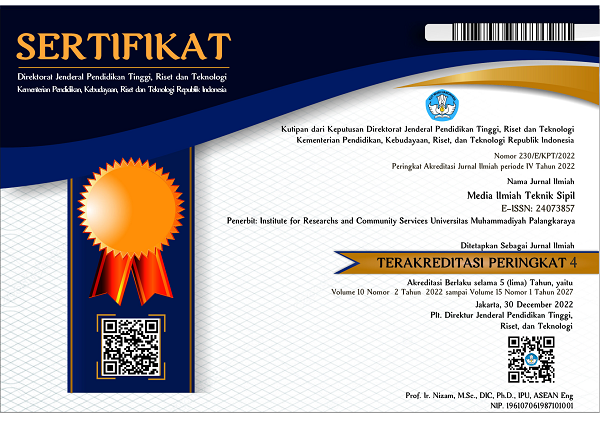Alternatif Sistem Penataan Infrastruktur Kawasan Permukiman Kumuh Di Kota Palangka Raya
Alternative Systems of Slum Settlements Region Infrastructure Planning in Palangkaraya city
DOI:
https://doi.org/10.33084/mits.v8i1.1132Keywords:
infrastruktur, kawasan permukiman kumuhAbstract
Environment Structuring is an important factor in settlement improvement efforts. As an indicator of clean and healthy neighborhoods that continuing environmental improvement quality can be measured by the presence or not, and good or poor infrastructure such as residential areas. The settlement Palangka Permai is located between the street G. Obos and Yos Sudarso Palangka Raya. It indicates that there are some drawbacks in terms of infrastructure feasibility aspects. Problems and objectives set out in this study are to determine the condition, causes and alternative systems of infrastructure arrangement residential area which is managed by the developer in the Palangkaraya city, as a basis for making alternative arrangement of the infrastructure systems to prevent neighborhoods from becoming a slum in Palangkaraya city. The results calculated scores to gauge the feasibility of infrastructure categories shows that the environmental aspect and location aspects of ordinary uncategorized. Aspects of road infrastructure, water and drainage, social facilities, buildings and technical of liquid and solid waste disposal have deserved fewer categories. The alternative system proposed settlement infrastructure is on Road infrastructure by optimizing the way the existing environment, create a new road axis, providing an environment of interconnected roads, procurement of drainage on either side of the road with a width and height of > 10% from width of pavement, optimizing the public open space, private open space, trees, and green layout, landscape and green belt areas as social facilities, oversight, and action on changes in appearance of buildings, by evaluating the ownership of the IMB and to make special rules to regulate of the building function, waste solid management (waste) needs to form an organization for the handling of waste. For the liquid wastes, handling is the local provider is to disposal wastewater system (on-site system) with system or septic tank and cubluk disposal centralized (off-site system) to create a closed channel to a combination of wastewater and surface water
Downloads
References
Catur Sugiyanto dan Bakti Setiawan, 2007. Kajian Aspek Kemasyrakatan di dalam Pengembangan Infrastruktur di Indonesia, Bandung: ITB
Diputra, I G, P. et al. 2004. Permukiman Kumuh di Denpasar: Ditinjau dari Aspek Ruang/Spesial. Laporan Penelitian, Denpasar: Jurusan Arsitektur Fakultas Teknik Univ. Udayana
Jayadinata, Johara, T, 1999, Tata Guna Tanah Dalam Perencanaan Pedesaan Perkotaan dan Wilayah, Penerbit ITB Bandung.
Kodoatie, Robert, J, 2005, Manajemen Infrastruktur, Yogyakarta: Pustaka Pelajar.
Keputusan Menteri Perumahan Rakyat No.4/KPTS/BKP4/1995, tentang Klasifikasi Rumah Tidak Bersusun.
Kuswartojo, Tjuk, 2005, Perumahan dan Permukiman di Indonesia; Upaya membuat Perkembangan kehidupan yang berkelanjutan, Bandung: Penerbit ITB.
Madesyawati, D. et al.2004, Analisis Rumah Kumuh Sebagai Tempat Produksi, Laporan Penelitian. Denpasar: Jurusan Arsitektur Fakultas Teknik Univ. Udayana
Peraturan Menteri Pekerjaan Umum No.06/Prt/M/2007 Tentang Pedoman Umum Rencana Tata Bangunan dan Lingkungan.
Peraturan Menteri Pekerjaan Umum No.54/PRT/1991 Tentang Pedoman Teknis Pembangunan Perumahan Sangat Sederhana.
Prasetyo, D. et al.2004, Pemukiman Kumuh di Denpasar: Ditinjau dari Aspek Sosial Budaya, Laporan Penelitian. Denpasar: Jurusan Arsitektur Fakultas Teknik Univ. Udayana
Rahmayanie, A.A. et al.2004, Aspek Finansial/Sosial Ekonomi Penduduk Permukiman Kumuh, Laporan Penelitian. Denpasar: Jurusan Arsitektur Fakultas Teknik Univ. Udayana
Reksohadiprodjo, 2001, Dimensi Lingkungan Perencanaan Pembangunan, Yogyakarta: Penerbit Gadjah Mada University Press.
Sastra M, Suparno dan Endy Marlina, 2006, Perencanaan dan Pengembangan Perumahan, Yogyakarta: Penerbit Andi.
Sujarto, Djoko, 1994, Proses Perkembangan dan Perencanaan Kota, Departemen Planologi FTSP, ITB, Bandung.
Undang-Undang Republik Indonesia Nomor 4 Tahun 1992 Tentang Perumahan dan Permukiman,
Undang-Undang Nomor 16 Tahun 1992 Tentang Rumah Susun.
Z,R, Langi, A, Wismadi, A, dkk, 2006 Pengembangan dan Manajemen Infrasruktur Indonesia yang Berkeadilan, UI, UGM, ITB.
Downloads
Published
How to Cite
Issue
Section
License
All rights reserved. This publication may be reproduced, stored in a retrieval system, or transmitted in any form or by any means, electronic, mechanical, photocopying, recording.







